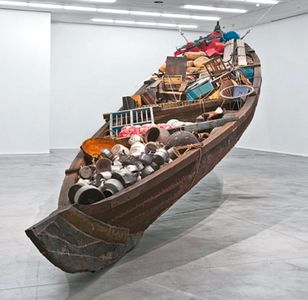Ever since 2012, one question that has been consistently confronting all of us at the Kochi Biennale Foundation is: how did you put up this incredible biennale? It is a question that does not have a one-word answer or can be explained in a sentence or two. “It just happened,” is our common refrain, though we all know that it took more than a village to establish it in Kochi. And, now, Kochi is on the global art map.
Recently, we were at the Tate Modern in London, demonstrating how to build a biennale. I was invited by Winchester School of Art (WSA), University of Southampton, as part of the celebrated ‘Tate Exchange’ programme, involving participants who were mostly students from various disciplines in the production of contemporary art. We explored how to make, organise, design space, curate and install or orchestrate works of art. The programme also included a variety of workshops to discover what it means to build art ‘events’, including the use of 3D digital scanning, an introduction to crowdfunding, participation in performance-based art and a series of daily thoughtful discussions.
According to the Tate website, Tate Exchange is “a space for everyone to collaborate, test ideas and discover new perspectives on life, through art”. It has more than 60 associates—charities to universities and health care trusts to community organisations from the UK and other parts of the world. And, it includes working within and beyond the arts in association with Tate Modern and Tate Liverpool.
In 2000, the derelict but historic Bankside powerhouse was converted into a grand museum by Swiss architects Herzog and De Meuron, and Tate Modern was born. Couple of years ago, it opened an annexe called the Blavatnik building—WSA held Tate Exchange on the fifth floor of this new building.
On the first day, we explored how to install a work, followed by a discussion between me and Tate Exchange participants on ‘Production’ as a concept and practice and the diverse biennale practice, especially in the context of the Kochi-Muziris Biennale (KMB). On the second day, national and international participants (including Jitish Kallat, second edition curator of KMB) were invited to submit proposals and formulate materials for the book, How to Biennale! The Manual, a practical guide for making your own art events.
Also, participants collaborated with Chinese calligraphy artist Zhang Qiang, making silk scrolls to be exhibited on the Tate Exchange floor. On the fifth day, Zuleikha Chaudhari, who participated in the third edition of KMB, devised an event called ‘The Ideal Spectator’, in which she held auditions for the position of spectator or even an impostor artist! Interestingly, Sudarshan Shetty, curator of the last biennale, was a participant and had a dialogue with Zuleikha later.
The last day was an open forum that discussed the future of biennales. The programme concluded with a live event, with the curator of the next edition of the KMB, Anita Dube, joining us from Kochi.
I have known Robert E. D’Souza, head of Winchester School of Art, and Sunil Manghani, professor of theory, practice and critique and director of doctoral research at WSA, since the inception of the KMB. Both of them have visited the biennale several times and have been part of the ‘History Now’ (art talk series at the KMB). They also published the first academic book on the KMB, India’s Biennale Effect: A Politics of Contemporary Art. The ‘How To Build An Art Biennale’ programme was conceptualised and organised by Tate Exchange, WSA and Shwetal Patel, consultant to the KMB.
I was overwhelmed by the response that the programme received. It was a great opportunity to meet incredible minds from the biennale world—artists, curators, writers, journalists, Tate members, Tate curators and, undoubtedly, the wonderful students of WSA. Drawing inspiration from the KMB, they produced three works based on Subodh Gupta’s Sea of God, Robert Montgomery’s text-based light works and the tents of Francesco Clemente. It was quite an unusual experience to watch students and tutors install the three massive works at the fifth floor of the impressive Blavatnik building.
editor@theweek.in


